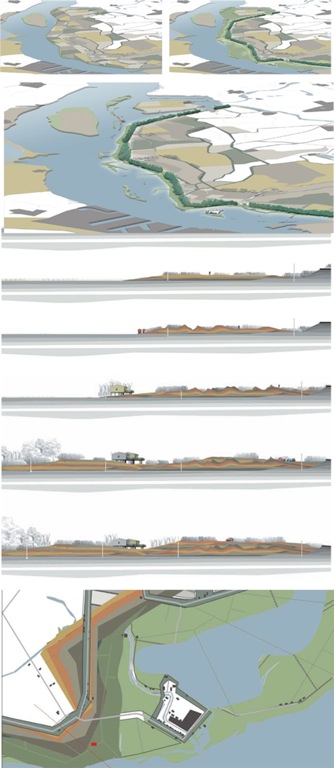The form of Dublin Bay at over 22 km is a fascinating dance of shifting mud, moving coastlines, sequences of constructed sea defences and hundreds of reclamation projects. It is a hugely dynamic coastline in a state of constant flux, shaped and designed by a thousand hands. Yet it has still to face its greatest challenge; ´the return of the sea´. Like many cities, Dublin has historically expanded along the low lying flood plains of its rivers, the Liffey, Tolka and Dodder estuaries, making it susceptible to the rise in sea levels due to climatic changes. This alarming fact of nature is no longer a fictitious risk but a real event that is currently in motion before our eyes. The predictions are data-based and the timelines can be measured in decennials rather than centennials. Radical intervention is required to redesign parts of the coast in order to secure Dublin from flooding events comparable with Sandy (2012) and the disastrous Great Flood of New Orleans (2005).
As a landscape architect with over 16 years experience in the Netherlands, the prospect of rising sea levels and living below sea level is neither upsetting nor alarming. The change is manageable. In fact currently whole swathes of Dublin are located below sea level, behind coastal defences that are gradually becoming insufficient to stem the tide. ´No change´ is not an option! And NIMBY reactions can’t be pushed down the road or solved with a call to your local TD.
Image credit: REDscape > Areas under sea level in Dublin
In defining the new coastal defences of Dublin we need to search laterally through design for these added opportunities. Instead of raised defences, we could be talking about new amenity areas. Instead of barriers, we could be talking about new park zones and connections to new habitats of marine flora and fauna. Dublin bay needs not just a defence but a design for its defences which embraces and optimises change to retaining existing values, while creating new qualities for the future. In the Netherlands, new coastal protection projects are seen as opportunities to innovate, and devise integrated solutions, often combining many different uses such as infrastructure, buildings, nature development, water management, dredge storage, parks and even housing with new defences. REDscape is currently working on the design and construction of the super dike that will house woodland, a new village of 1300 houses and a marina for the city of Kampen. The so- called ‘super dike’, is the first inhabited primary dike in the Netherlands for over 50 years. This culture of design and innovation is lead by the Ministry of Water, an approach our new Water Board will hopefully be inspired by.
Image credit: DP6 architectuurstudio Delft > The hollow dike in Katwijk.
The contribution of design to the process has been essential in delivering more creative solutions in the Netherlands with multi faceted uses. The delivery of flooding defences is seen as a collaborative task for engineers, landscape architects, urbanists and ecologists alike. Once technical starting points have been established by the engineers, designers are requested to develop the design further in a collaborative process. With their design skills and ability to integrate uses, visualise and communicate to the public, landscape architects and other designers have been pushed to the fore of these new national projects.
Image credit: Dingeman Deijs & Steven Delva landscape architects. > Multifunctional dike.
A new national programme of defences around the Ijsselmeer and Amsterdam has delivered a combination of new solutions from raised dikes and offshore buffer systems to dune making and dike buildings to name but a few. Many of these solutions encompass a concept I call ‘engineering with landscape’ in which the natural dynamics of landscape are introduced into the process of defence building itself. Dune making is a good example of this process, as are other forms such as the dredge dike shown here, in which newly pumped dredge is transported from the Rhine inland to construct a dike over thirty years. Can engineering with landscape be applied to Dublin? Can our offshore wind farms provide tidal protection? Can the dynamics of our coastline deliver natural defences?
Image credit: REDscape landscape & Urbanism > The dredge dike, a dike built over 25 years with lightly polluted dredge from the Rhine. The new dikes create more storage space for the Rhine in the form of inundation polders during peak flows.
Ireland has still yet to develop an integrated approach to designing its flooding defences. Although government departments earmarked €350 million for flood defences in 2010, there were no funds allocated to design or innovation of these new defences. Surely a programme of such national importance so intrinsically related to the quality of our landscape, towns and cities deserves to be properly designed. Is it not time that our policy makers recognise the role and importance of design in our national infrastructure projects and develop adequate measures to include these in a meaningful way in our public tendering processes?
Patrick Mc Cabe is a landscape architect and founder of REDscape, a design office for landscape and urbanism that delivers solutions for spatial questions. Patrick has recently been involved in redeveloping the harbour quarter in Deventer, a self build, bottom up development in an existing industrial area in the Netherlands. REDscape specialises in integrated design for cities, harbours and industrial areas with a focus on water management and flood defences. See, for example, redscape.nl/project/green-port-dublin/
The Commnetary was originally published as a Blog entry in PIVOT Dublin, a Dublin City Council initiative, devised and co-ordinated by Dublin City Architects, because cities that value and apply design in how they think plan and act are more humane, attractive and competitive. www.pivotdublin.com/index.php/blog







No comments yet, add your own below